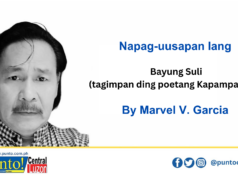“WITH THIS historical marker from the Philippine national government, the truth can now be told: Macabebes did it to avenge all kinds of persecution committed against them by their fellow Filipinos, culminating in the burning of the town and the massacre of 300 townspeople inside the church. No, it wasn’t dugong aso after all that made them do it—it was vengeance. It was never an act of treachery, but an act of revenge.”
Thus, Center for Kapampangan Studies director Robby Tantingco succinctly exacted, indeed impacted, the truth to the long-held canard of a canine bloodline in the Kapampangan right at the commemoration of the 125th anniversary of “The Burning of Macabebe” on April 27. 2024.
Tantingco could have spoken with the voice of an angel: Soon as the marker from the National Historical Commission of the Philippines was unveiled, a mongrel strayed in front of the assembled guests, moving Robby to enthuse: “As this dog leaves the scene, may the tag dugong aso also stop hounding Kapampangans once and for all.”
No other contemporary Kapampangan of note has done as much as Tantingco in expunging that blot in the Kapampangan character, advancing his advocacy at every opportunity, given or not.
Like in November 2018, on his Facebook page: “Have you noticed? There is hardly any Filipino anymore who calls Kapampangans dugong aso. We have successfully asserted ourselves and changed the conversation to the other narratives of the multi-layered story of our amazing people. So, once and for all, and to put the last nail on the coffin of this subject matter, let us stop blaming the Macabebe Scouts alone…for the capture of Aguinaldo in Palanan in 1901…”
That last nail, the historical marker hammered last Saturday.
Least a Kapampangan bias, all of historical fact whence Tantingco speaks, complete with mug shots and briefs of the dastardly deeds of the actual Aguinaldo betrayers, identified as Spanish Capt. Lazaro Segovia, Ilocano Cecilio Seguismundo, and Tagalog Maj. Hilario Talplacido.
“And yet it was the foot soldiers, the Macabebes, who bore the brunt of the nation’s anger which resulted in the unfair racial profiling of all Kapampangans as traydor and dugong aso.” So lamented Tantingco.
Rightly, and reasonably, Robby: “How could the Macabebes, who never served in Aguinaldo’s army and therefore could not have betrayed him, be branded as traitors, and not these three defectors? They were merely doing their job as hired soldiers of the American military, and were actually exacting vengeance on a man they hated with all their heart and soul (for killing Andres Bonifacio whose roots were in Macabebe, and for ordering the burning of the Macabebe church).”
Commented I to Robby’s post: From another perspective, the Macabebe scouts should even be hailed as heroes. Aguinaldo’s messianic delusions deprived the revolution of its father, Bonifacio and its only real military brains, Luna.
Of this shameful sobriquet slapped on the Kapampangan, I have also written a handful. Indulge me now with this one from way, way back.
…DOGS ARE clichéd as man’s best friend, yet they tend to get the choicest cuts in the worst insults. “Gone to the dogs,” for instance.
Sen. Miriam Defensor-Santiago riled the usually cat-cool Sen. Panfilo Lacson not so much for calling him “Pinky” as for branding him as Sen. Juan Ponce Enrile’s “attack dog.” Warranting a reply in kind from the former top cop. A case of “dog-eat-dog” there?
“Tuta ng Kano.” So, the militant Left derided Ferdinand E. Marcos, Cory Aquino and all those who followed them to Malacanang down to Cory’s son BS.
Even the venerable Carlos P. Romulo, who served eight Philippine presidents – from Quezon to Marcos – and who himself sat as president – of the Fourth Session of the United Nations General Assembly in 1949-1950, was not spared of a similar epithet. No idle urban legend but a revealed truth to student activists of the First Quarter Storm was Chou En-Lai’s dismissal of Romulo as “America’s running dog” at the Bandung Conference of Asian and African nations in 1955 that helped crystallized the Non-Aligned Movement.
At the time of Cory too, I remember the Malacanang Press Corps raising a howl over a presidential factotum’s obvert reference to them as mongrels when he directed his staff to “feed the kennel” whenever his office issued press releases.
For too long a time, a collective insult, indeed, a curse, to the whole Kapampangan race is the branding dugong aso.
In 1981, the political leadership of Pampanga – from Gov. Estelito P. Mendoza, Vice Gov. Cicero J. Punzalan, down to the mayors led by the “Big 5” of San Fernando’s Armando Biliwang, Arayat’s Benigno Espino, Magalang’s Daniel Lacson, Sta. Ana’s Magno Maniago, and Sta. Rita’s Frank Ocampo, along with Angeles City’s Francisco G. Nepomuceno, raged and ranted rabidly at then Olongapo City Mayor Richard J. Gordon for citing the Kapampangans as dugong aso in the context of regionalism’s ill-effects to nationalism in his nomination speech for Ferdinand E. Marcos in the KBL party convention at the Manila Hotel.
Actual physical threats were even thrown Gordon’s way in addition to some persona non grata resolutions. (Gordon’s topping Pampanga in the senatorial contest of May 2013 is some vindication of the forgiving-and-forgetting nature of this race.)
Lapid
Even as dugong aso stuck to the Kapampangan, the insult accruing thereat has largely dissipated. This is owed to an extent to then Gov. Lito Lapid, as we wrote here sometime ago:
“Ikinagagalit nating mga Kapampangan ang pagtawag sa atin ng ‘dugong aso.’ Subali’t ito ay ipinagmamalaki’t ikinararangal ko. Sa katapatan, wala nang mauuna pa sa aso: sa kanya iniiwan ng amo ang tahanan nito, pati na magkaminsan ang pagtatanggol sa kanyang pamilya. Subukin mong saktan ang amo, at tiyak, dadambain ka ng kanyang aso. Ang katapatang ito ang iniaalay ko sa inyo.”
Before a beaming President Ramos at the Mawaque Resettlement Project site in 1997, Lapid pledged his loyalty in gratitude for the new lease on human decency, on human life itself that El Tabaco bestowed upon those the Mount Pinatubo eruptions devastated, displaced and dispossessed.
Thence, the Bida embraced FVR’s Lakas-NUCD with a fidelity his wife could only wish he committed to his marital vows with as much devotion, if not intensity.
Lapid there made a rarity: loyalty being an uncommon commodity in politics. So, what is it that makes politicians and adulterers one and the same as a dysfunctional radio? Low fidelity on a high frequency, dummy…
There too was Lapid giving a novel and noble meaning to the derogatory dugong aso impacted in the Kapampangan psyche, extolling it as the virtue of katapatan, of dogged loyalty to an elder, to a superior, to a friend. No mean feat for the uncolleged Lapid.
But for the title “Of dogs and men,” there is very little I remember of a column I wrote in The Voice in the late ‘70s. It would have made a most relevant read in the subject I am discussing here. The ending of that column though is something I cannot possibly just easily forget, having consigned it as much to the mind as to the heart and put out at every opportunity that calls for it, like now.
A lesson in loyalty – of dogs, as well as of men – perfectly captured in that blurb of an award-winning Lino Brocka movie: “Sa bawa’t latay, kahit aso’y nag-iiba. Sa unang latay, siya’y magtatanda; Sa ikalawa, siya’y mag-iisip; Sa ikatlo, siya’y magtataka; Sa ika-apat, humanda ka!”
Caveat canis. Yes, there is more to what the Latins of old put up at their gates than its literal meaning.




